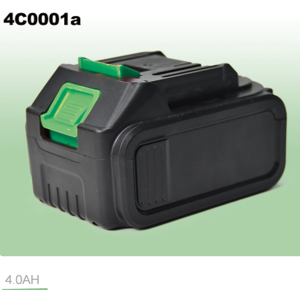In 2023, one of the most discussed topics in the power tool industry regarding lithium battery technology was Bosch's 18V Infinite-Ear Lithium Battery platform. So, what exactly is this Infinite-Ear Lithium Battery technology?
The Infinite-Ear (also known as Full-Ear) battery is an innovatively designed lithium-ion battery. Its distinguishing feature lies in the elimination of the conventional motor terminals and tabs (metal conductors) found on traditional batteries. Instead, the positive and negative terminals of the battery are directly connected to the battery casing or cover plate, acting as electrodes. This design increases the area for current conduction and reduces the conduction distance, thereby significantly lowering the internal resistance of the battery. Consequently, it enhances the peak power during charging and discharging, while also improving the battery's safety and energy density. The structural design of the Infinite-Ear battery allows for larger dimensions and higher energy capacity within cylindrical battery cells.

Bosch's ProCORE18V+ 8.0Ah battery benefits from the Infinite-Ear battery technology, which features numerous parallel current paths to reduce internal resistance and heat. By incorporating the Infinite-Ear battery technology and pairing it with COOLPACK 2.0 thermal management, the ProCORE18V+ 8.0Ah battery helps ensure longer battery life. Compared to the original 18V platform, Bosch's release of the 18V Infinite-Ear Lithium Battery platform offers significant advantages such as longer runtime, lighter weight, and higher efficiency. These advantages align with the trend in lithium-ion tool development, making Bosch's Infinite-Ear battery release a significant technological advancement in the industry.
In recent years, global technicians have been making relentless efforts to improve power tools. From wired to wireless, from 18650 to 21700, from 21700 to polymer, and now to the Infinite-Ear technology, each innovation has driven industry transformation and become a focus of technological competition among international lithium battery giants such as Samsung, Panasonic, LG, and Panasonic. Although the product has been released, questions remain about whether the battery suppliers for these brands have achieved mass production of this technology. The release of Bosch's new technology has also sparked some attention in the domestic lithium battery industry. However, most leading companies are gradually perfecting existing products and preparing for new technologies, while some unknown lithium battery companies have started to "perform".
As for whether domestic lithium battery brands have mastered this core technology, on March 12th, Jiangsu Haisida Power Co., Ltd. and Zhejiang Minglei Lithium Energy reached a strategic cooperation and jointly established the Infinite-Ear Power Lithium Battery Joint R&D Laboratory. This indicates that leading domestic lithium battery brands have just entered the preliminary stage of this threshold, and mass production is still a certain distance away. Industry insiders have revealed that the Infinite-Ear technology is challenging, as controlling the compression of metal fragments is complex, and some manufacturing equipment is mainly imported from Japan and South Korea. Even Japan and South Korea have not yet achieved mass production, and if they do, priority will be given to the automotive industry due to its larger volume compared to appliances and tools.
Currently, various marketing methods are rampant in the domestic lithium battery industry, with many companies vigorously promoting their Infinite-Ear batteries to attract attention. Interestingly, some manufacturers haven't even excelled in producing ordinary lithium batteries but claim to have been preparing for the "technology" of such complex products for many years. With yesterday being the "March 15th Consumer Rights Day", this field seems to require some regulation. Therefore, in the face of new technology, it is important to remain rational and not blindly follow trends. Only technologies that withstand scrutiny are truly the new directions for the industry. In conclusion, currently, the hype surrounding these technologies may outweigh their practical operational significance, but they are still worth researching as new directions.
Post time: Mar-22-2024



